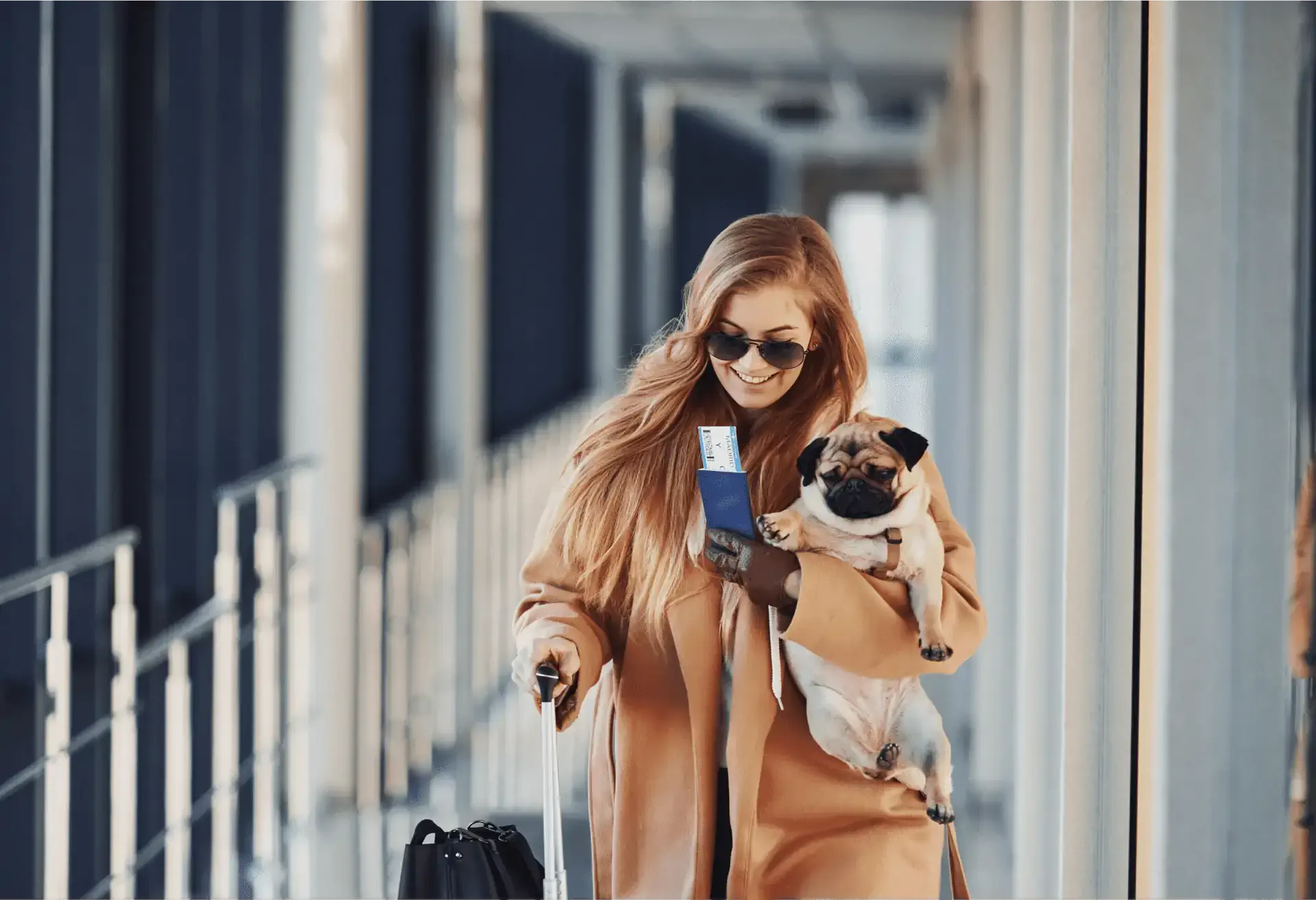As pets have evolved more and more into full-fledged members of the family, owners have begun including their four-legged friends in their travel plans. And that means flying. Airlines have adjusted their policies, too, allowing for pets to travel in cabins with their owners in most cases, provided the animal is small enough to fit in a pet carrier. While a 68-kilogram Mastiff or 34-kilogram Lab obviously won’t qualify, most small dogs and cats will.
To ensure a safe flight, it’s important that owners recognize the health needs of their pets – those that are especially important 35,000 feet in the air. Here are some guidelines to help both pets and their owners fly comfortably.
Before you fly
Start by checking your airline’s website for regulations, but also get a verbal confirmation that you and your pet are set to fly. Many airlines limit the total number of animals allowed within the cabin on each flight, so it’s important that a reservation be made sooner rather than later and confirmed 24-48 hours before departure. In addition, here are some other pre-flight guidelines to keep in mind.
- Choose direct flights to minimize the time your pet is travelling.
- If you’re flying during winter or summer months, be sure that both the hold of the plane and the cargo facilities at the airport are climate controlled. Ask the airline if you need to get an acclimation certificate from your vet, showing that your animal is cleared to fly in temperatures lower than 7 degrees Celsius.
- Make sure your pet is adequately insured and that the policy covers travel. If you don’t have insurance coverage for your furry friend, consider getting it.
- Be aware of destination-specific restrictions. Hawaii, for instance, is a rabies-free state and some animals could be quarantined for up to 120 days upon arrival.
Preparation
First-time fliers are sometimes overwhelmed, so there are a few things you can do to make the situation easier. First, it’s important to schedule trial runs before the big day. If you live in a city, take your pet for a ride on the subway or other mode of public transportation to familiarize them with both the movement and the crowds.
When it comes time to deciding what your pet will be travelling in, considering their comfort is a must. Squeezing your dog or cat into the claustrophobic kennel you purchased when they were just wee ones won’t do on a flight, whether short- or long-haul. Invest in a container that leaves your pet room to turn and stand up without hitting their head on the top of the carrier. Different airlines have different dimension requirements, though the universal must-haves include food and water dishes, bedding and other necessities. Remember to include objects that the animal is familiar with, whether it’s a favourite toy or cozy blanket from home.
In case of separation, it’s important to mark your pet – as well as carrier – with proper ID tags. Attach to the kennel a note with your flight number, contact information and pet’s name. Do the same on your pet’s collar; remember that a reachable phone number is the most important detail.
Though individual airlines’ requirements vary, these additional guidelines are universal:
- Per Federal Aviation Administration regulations, the pet carrier must be small enough to fit under the seat in front of you, allowing for other passengers to easily reach the aisle.
- Your animal must be at least eight weeks old and fully weaned.
- For dogs, have a collar and leash handy to walk your pet once deplaned.
- Each crate should contain separate bowls for water and food, accessible from the inside (Tip: It’s also a good idea to keep an extra serving or two of food in a bag taped to the top of the carrier in case of any delays, along with a notice asking for your pet to be fed by a certain time if you’re delayed in picking them up.)
- Write the words “Live Animal” on the sides and top of the carrier, along with arrows to indicate the top of the crate.
- Keep a recent photo of your furry friend handy in the rare event that they escape or go missing. Keep one set of copies for yourself, and place another set in an envelope securely taped to the top of the crate.
Health
A healthy pet is a happy pet and also a pet who will be a better traveller. So, for starters, spoil your dog or cat the day before travelling with extra exercise, the goal being to wear them out. For dogs, this means longer walks and high-energy activities; for cats, a few extra games of Claw the Rope could do.
In addition, just like us, dogs and cats get dehydrated on flights. A handy tip: Freeze water before you leave home to ensure your furry friend has water in his dish by the time you both pass through security.
Also, you will certainly want to familiarize yourself with the locations of pet relief stations in the airports you’re flying in and out of. Check out our guide to in-terminal airport pet relief stations for more info.
Some airlines don’t require vaccination or health and veterinarian documents for animals on domestic flights. However, it’s still recommended that pet owners visit their vet before trips and carry up-to-date medical records and a first aid kit (gauze, tape, eye dropper, etc.) on flights. Many airlines require you to carry a health certificate issued less than 30 days before departure. To play it extremely safe, get acquainted with local veterinarians at your destination in case your cat or dog gets sick or injured while away. A few more healthy travel tips are below.
- If your animal has pet health insurance, make sure it’s current, and have a copy of the insurance card or member information with you, as well as attached to the pet carrier.
- Sedation is discouraged since sedatives and high altitudes can be a deadly combination. Some airlines will refuse to fly a sedated animal.
- Do not feed your pet for four to six hours before travelling, though it’s crucial to provide water in a spill-proof bowl.
Cost of a kennel versus flying with your pet
The charges associated with carrying pets onboard – whether checked or in the cabin – add up quickly. Research airlines’ different rates ahead of time and factor the canine and feline fees into the total cost of airfare – both yours and your pet’s – before pressing book. Consider this chart, which outlines the cost of taking your pet on board for several popular airlines.
| Airline | Cabin fee, by segment | Checked fee, one-way | Maximum kennel size (cabin) | Maximum kennelsize (checked) |
| Air Canada | $50/$100 | $105 and up | 55cm L x 40cm W x 23cm H | 292 cm, linear dimensions |
| Alaska Airlines | $100 | $100 | 43xm L x 30cmW x 19cm H | 101cm L x 68cm W x 76cm H |
| American Airlines | $125 | $175 | 48cm L x 33cm W x 22cm H | 101cm L x 68cm W x 76cm H |
| British Airways | Varies, based on weight & destination | Varies, based on weight & destination | Varies, based on weight & destination | Varies, based on weight & destination |
| Delta Air Lines | $125 | $200 | 45cm L x 26cm H x 27cm W | 121cm L x 81cm W x 89cm H |
| JetBlue Airways | $100 | n/a | 43cm L x 31cm W x 21cm H | Checked pets not allowed |
| Porter Airlines | $50 | n/a | 55cm L x 40cm W x 23cm H | Checked pets not allowed |
| Southwest Airlines | $75 | n/a | 48cm L x 35cm W x 21cm H | Checked pets not allowed |
| United Airlines | $125 | $250 | 44cm L x 30cm W x 19cm H | 121cm L x 81cm W x 89cm H |
| US Airways | $125 | n/a | 43cm L x 40cm W x 20cm H | Checked pets not allowed |
| WestJet | $50 | $50 | 40cm L x 44cm W x 21.5cm H | 91cm L x 61cm W x 66cm H |
Your other option is to board your furry friend in a kennel. While kennel costs vary, on average, based on the cost of boarding cats and dogs in various major Canadian cities, you can expect to pay between $18 and $25 per day to board a cat and between $30 and $40 per day for dogs, depending on their size. Which is cheaper, kennel versus travelling with your pet, will depend on how long you’re going to be gone.
It’s also important to factor in costs of vaccinations if your pet isn’t up to date with shots. The shots your pet requires will vary from airline to airline, destination to destination and kennel to kennel so make sure to check before you book your trip.
In the end, travelling with your pet requires flexibility and patience, virtues that every traveller should possess. Whether your flight is delayed, your dog gets sick mid-flight, or your cat decides he can’t wait for the litter box – taking pets up in the air can be tough. Bottom line: plan for the worst and expect the best.
Featured image: ocean yamaha, Moo_Perl_Under_table via Flickr CC BY 2.0



